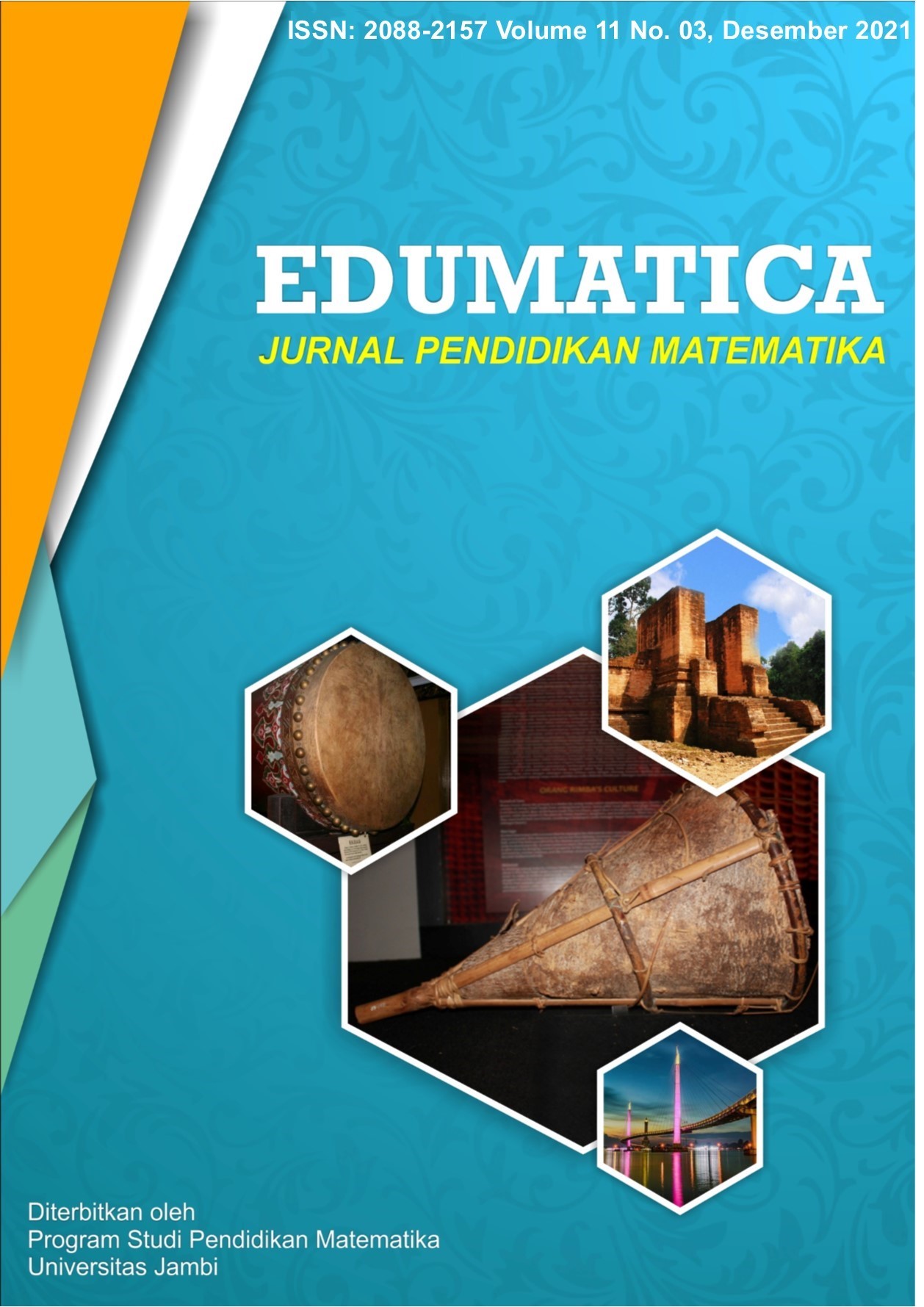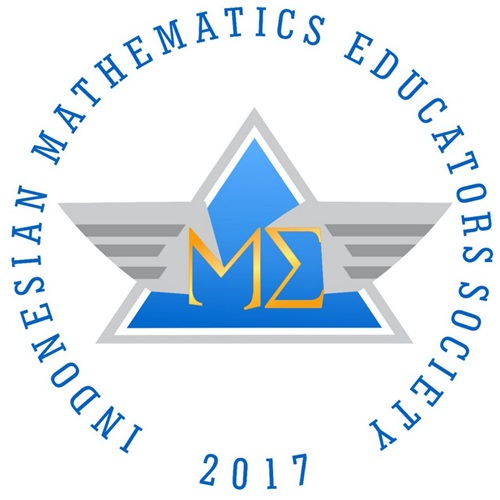Students' Difficulties in Solving Problems with Math Story Problems Seen from Adversity Quotient (AQ)
DOI:
https://doi.org/10.22437/edumatica.v11i03.15395Keywords:
adversity quotient, difficulty, problem solvingAbstract
Problem solving is one of the main goals in learning mathematics and can be realized in solving story problems. The purpose of this study is to describe the difficulties of climbers, campers and quitters' students in solving mathematical problems in the form of story questions based on Polya's steps. This research uses qualitative research with a case study approach design. The instrument is the researcher himself and the supporting instruments are questionnaires, problem solving test instruments and interviews. The population in this study were students of SMPK Mardi Wiyata Malang class VIII B which were taken 6 subjects (2 Climber students, 2 Camper students and 2 Quitter students) based on the results of Adversity Response Profile (ARP) questionnaire data. The results in this study consist of the difficulty of climber students in solving problem solving, namely the difficulty in solving problems and making conclusions from the problems that have been solved. Camper students' difficulties in solving problem solving are difficulties in planning problem solving strategies, problems solving and drawing conclusions from the problems given. The difficulty of quitter students in solving problem solving is the difficulty of students in understanding problems, planning solutions, making solutions and drawing conclusions from the problems given. Based on the findings, students with the quitter category have the lowest ability in the problem-solving process. Therefore, further research is needed to increase the motivation and interest in learning of students belonging to the quitter category.
Downloads
References
Agnesti, Y., & Amelia, R. (2020). Penerapan Pendekatan Kontekstual dalam Menyelesaikan Soal Cerita pada Materi Perbandingan dan Skala terhadap Siswa SMP. Mosharafa: Jurnal Pendidikan Matematika, 9(2), 347-358. https://doi.org/10.31980/mosharafa.v9i2.748
Ahdhianto, E., Marsigit, M., Haryanto, H., & Nitya, N. (2020). The Effect of Metacognitive-Based Contextual Learning Model on Fifth-Grade Students’ Problem-Solving and Mathematical Communication Skills. European Journal of Educational Research, 9(2), 753-764. https://doi.org/10.12973/eu-jer.9.2.753
Aisyah, A. S., Riyadi, R., & Subanti, S. (2021). Description of the Difficulty Of Students’ Mathematics Problem Solving Assessed from Adversity Quotient (AQ). AKSIOMA: Jurnal Program Studi Pendidikan Matematika, 10(2), 1161. https://doi.org/10.24127/ajpm.v10i2.3663
Arfiana, A., & Wijaya, A. (2018). Problem Solving Skill of Students of Senior High Schools and Islamic High Schools in Tegal Regency in Solving the Problem of PISA based on Polya’s Stage. Jurnal Riset Pendidikan Matematika, 5(2), 211-222. https://doi.org/10.21831/jrpm.v5i2.15783
Bray, A., & Tangney, B. (2017). Technology Usage in Mathematics Education Research - A Systematic Review of Recent Trends. Computers & Education, 114, 255-273. https://doi.org/10.1016/j.compedu.2017.07.004
Coronata, C., & Alsina, Ã. (2014). Evaluation of the Mathematical Processes in the Practices of Teaching and Learning in Childhood Education. Procedia - Social and Behavioral Sciences, 141, 1320-1323. https://doi.org/10.1016/j.sbspro.2014.05.227
Depdiknas. (2006). Peraturan Menteri Pendidikan Nasional No.22 Tahun 2006 Tentang Standar Isi. BSNP.
Desli, D., & Lioliou, A. (2020). Relationship between Computational Estimation and Problem Solving. International Electronic Journal of Mathematics Education, 15(3), em0602. https://doi.org/10.29333/iejme/8435
Duris, F. (2018). Arguments for the Effectiveness of Human Problem Solving. Biologically Inspired Cognitive Architectures, 24(April), 31-34. https://doi.org/10.1016/j.bica.2018.04.007
Erfani, G. A., Rokhman, M. S., & Sholikhakh, R. A. (2020). Analisis Kesalahan Siswa dalam Menyelesaikan Soal Cerita Matematika Materi Aritmetika Sosial Menurut Polya. AKSIOMA : Jurnal Matematika Dan Pendidikan Matematika, 11(2), 306-314. https://doi.org/10.26877/aks.v11i2.6850
Garcia, T., Boom, J., Kroesbergen, E. H., Núñez, J. C., & RodrÃguez, C. (2019). Planning, Execution, and Revision in Mathematics Problem Solving: Does the Order of the Phases Matter? Studies in Educational Evaluation, 61(February), 83-93. https://doi.org/10.1016/j.stueduc.2019.03.001
Guner, P., & Erbay, H. N. (2021). Prospective Mathematics Teachers’ Thinking Styles and Problem-Solving Skills. Thinking Skills and Creativity, 40(February), 100827. https://doi.org/10.1016/j.tsc.2021.100827
Haataja, E., Garcia Moreno-Esteva, E., Salonen, V., Laine, A., Toivanen, M., & Hannula, M. S. (2019). Teacher’s Sisual Attention When Scaffolding Collaborative Mathematical Problem Solving. Teaching and Teacher Education, 86, 102877. https://doi.org/10.1016/j.tate.2019.102877
Hauge, K. H., & Barwell, R. (2017). Post-normal Science and Mathematics Education in Uncertain Times: Educating Future Citizens for Extended Peer Communities. Futures, 91, 25-34. https://doi.org/10.1016/j.futures.2016.11.013
Hendriana, H., Purwasih, R., Triawan, E., Prasetio, Y., & Satria, T. (2018). Analysis of Student Problem Solving Skill and Activity Concentration on a Senior High School. Al-Jabar : Jurnal Pendidikan Matematika, 9(1), 1. https://doi.org/10.24042/ajpm.v9i1.2068
Hidayat, W., & Sariningsih, R. (2018). Kemampuan Pemecahan Masalah Matematis dan Adversity Quotient Siswa SMP Melalui Pembelajaran Open Ended. Jurnal JNPM (Jurnal Nasional Pendidikan Matematika), 2(1), 109-118. https://doi.org/10.33603/jnpm.v2i1.1027
Jasira, L., Ramadhona, R., & Tambunan, L. R. (2018). Pengaruh Model Pembelajaran Problem Based Learning terhadap Kemampuan Pemecahan Masalah Matematika. Lestari, 7(September), 51-62.
Ke, F., & M. Clark, K. (2020). Game-Based Multimodal Representations and Mathematical Problem Solving. International Journal of Science and Mathematics Education, 18(1), 103-122. https://doi.org/10.1007/s10763-018-9938-3
Kenedi, D. (2019). Koneksi Matematika Siswa SD untuk Memecahkan Masalah Matematika. Journal on Mathematics Education, 10(1), 69-79.
Kirisci, N., Sak, U., & Karabacak, F. (2020). The Effectiveness of the Selective Problem Solving Model on Students’ Mathematical Creativity: A Solomon Four-Group Research. Thinking Skills and Creativity, 38(August), 100719. https://doi.org/10.1016/j.tsc.2020.100719
Lee Swanson, H., Arizmendi, G. D., & Li, J.-T. (2021). Working Memory Growth Predicts Mathematical Problem-Solving Growth Among Emergent Bilingual Children. Journal of Experimental Child Psychology, 201, 104988. https://doi.org/10.1016/j.jecp.2020.104988
Lester, F. K. (2013). Thoughts About Research on Mathematical Problem-Solving Instruction. The Mathematics Enthusiast, 10(1), 245-278.
Lewy, L. (2013). Pengembangan Soal untuk Mengukur Kemampuan Berpikir Tingkat Tinggi Pokok Bahasan Barisan dan Deret Bilangan di Kelas IX Akselerasi SMP Xaverius Maria Palembang. Jurnal Pendidikan Matematika, 5(1). https://doi.org/10.22342/jpm.5.1.821.
Li, L., Zhou, X., Huang, J., Tu, D., Gao, X., Yang, Z., & Li, M. (2020). Assessing Kindergarteners’ Mathematics Problem Solving: The Development of a Cognitive Diagnostic Test. Studies in Educational Evaluation, 66(May 2019), 100879. https://doi.org/10.1016/j.stueduc.2020.100879
Lupu, C. (2014). The Model Object-product-cognitive Operation Through Mathematical Education. Procedia - Social and Behavioral Sciences, 163, 132-141. https://doi.org/10.1016/j.sbspro.2014.12.298
Maf’ulah, S., & Juniati, D. (2020). The Effect of Learning with Reversible Problem-Solving Approach on Prospective-Math-Teacher Students’ Reversible Thinking. International Journal of Instruction, 13(2), 329-342. https://doi.org/10.29333/iji.2020.13223a
Molina del RÃo, J., Guevara, M. A., Hernández González, M., Hidalgo Aguirre, R. M., & Cruz Aguilar, M. A. (2019). EEG Correlation During the Solving of Simple and Complex Logical-Mathematical Problems. Cognitive, Affective, & Behavioral Neuroscience, 19(4), 1036-1046. https://doi.org/10.3758/s13415-019-00703-5
Naisunis, Y. P., Taneo, P. N. L., Daniel, F., Studi, P., Matematika, P., & Stkip, S. (2018). Analisis Kesalahan Mahasiswa dalam Pemecahan Masalah pada Mata Kuliah Persamaaan Diferensial Yuliana. Edumatica, 08(02).
Novferma, N. (2016). Analisis Kesulitan dan Self-Efficacy Siswa SMP dalam Pemecahan Masalah Matematika Berbentuk Soal Cerita. Jurnal Riset Pendidikan Matematika, 3(1), 76. https://doi.org/10.21831/jrpm.v3i1.10403
Nuraini, Maimunah, & Roza, Y. (2019). Analisis Kemampuan Pemecahan Masalah Siswa Kelas VIII SMPN 1 Rambah Samo pada Materi Bangun Ruang Sisi Datar. Numerical: Jurnal Matematika Dan Pendidikan Matematika, 3(1), 63-76.
Phonapichat, P., Wongwanich, S., & Sujiva, S. (2014). An Analysis of Elementary School Students’ Difficulties in Mathematical Problem Solving. Procedia - Social and Behavioral Sciences, 116(2012), 3169-3174. https://doi.org/10.1016/j.sbspro.2014.01.728
Rahayu, N., & Alyani, F. (2020). Kemampuan Berpikir Kritis Matematis Ditinjau dari Adversity Quotient. Prima: Jurnal Pendidikan Matematika, 4(2), 121. https://doi.org/10.31000/prima.v4i2.2668
Rahayuningsih, S., Sirajuddin, S., & Nasrun, N. (2020). Cognitive Flexibility: Exploring Students’ Problem-Solving in Elementary School Mathematics Learning. JRAMathEdu (Journal of Research and Advances in Mathematics Education), 6(1), 59-70. https://doi.org/10.23917/jramathedu.v6i1.11630
Ridwan, M. R., Retnawati, H., Hadi, S., & Jailani, J. (2021). The Effectiveness of Innovative Learning on Mathematical Problem-Solving Ability: A Meta-Analysis. International Journal of Research in Education and Science, 7(3), 910-932. https://doi.org/10.46328/ijres.2287
Santia, I., Purwanto, Sutawidjadja, A., Sudirman, & Subanji. (2019). Exploring Mathematical Representations in Solving ILL-Structured Problems: The Case of Quadratic Function. Journal on Mathematics Education, 10(3), 365-378. https://doi.org/https://doi.org/10.22342/jme.10.3.7600.365-378
Sari, I., Marwan, M., & Hajidin, H. (2019). Students’ Thinking Process in Solving Mathematical Problems in Build Flat Side Spaces of Material Reviewed from Adversity Quotient. Malikussaleh Journal of Mathematics Learning (MJML), 2(2), 61-67. https://doi.org/10.29103/mjml.v2i2.1468
Schoenfeld, A. H. (2016). Learning to Think Mathematically: Problem Solving, Metacognition, and Sense Making in Mathematics (Reprint). Journal of Education, 196(2), 1-38. https://doi.org/10.1177/002205741619600202
Setiyani, S., Fitriyani, N., & Sagita, L. (2020). Improving Student’s Mathematical Problem Solving Skills Through Quizizz. JRAMathEdu (Journal of Research and Advances in Mathematics Education), 5(3), 276-288. https://doi.org/10.23917/jramathedu.v5i3.10696
Sholihah, S. Z., & Afriansyah, E. A. (2018). Analisis Kesulitan Siswa dalam Proses Pemecahan Masalah Geometri Berdasarkan Tahapan Berpikir Van Hiele. Mosharafa: Jurnal Pendidikan Matematika, 6(2), 287-298. https://doi.org/10.31980/mosharafa.v6i2.317
Singh, S., & Sharma, T. (2017). Affect of Adversity Quotient on the Occupational Stress of IT Managers in India. Procedia Computer Science, 122, 86-93. https://doi.org/10.1016/j.procs.2017.11.345
Stolz, P. G. (2000). Adversity Quotient: Mengubah Hambatan Menjadi Peluang. Gramedia Widiasarana Indonesia (GRASINDO).
Tambychik, T., & Meerah, T. S. M. (2010). Students’ Difficulties in Mathematics Problem-Solving: What Do They Say? Procedia - Social and Behavioral Sciences, 8(5), 142-151. https://doi.org/10.1016/j.sbspro.2010.12.020
Toraman, C., Orakcl, S., & Aktan, O. (2020). Analysis of the Relationships between Mathematics Achievement, Reflective Thinking of Problem Solving and Metacognitive Awareness. International Journal of Progressive Education, 16(2), 72-90. https://doi.org/10.29329/ijpe.2020.241.6
Ukobizaba, F., Nizeyimana, G., & Mukuka, A. (2021). Assessment Strategies for Enhancing Students’ Mathematical Problem-solving Skills: A Review of Literature. Eurasia Journal of Mathematics, Science and Technology Education, 17(3), em1945. https://doi.org/10.29333/ejmste/9728
Wang, X., Liu, M., Tee, S., & Dai, H. (2021). Analysis of Adversity Quotient of Nursing Students in Macao: A Cross-Section and Correlation Study. International Journal of Nursing Sciences, 8(2), 204-209. https://doi.org/10.1016/j.ijnss.2021.02.003
Yandari, I. A. V., Supartini, S., Pamungkas, A. S., & Khaerunnisa, E. (2019). The Role of Habits of Mind (HOM) on Student’s Mathematical Problem Solving Skills of Primary School. Al-Jabar : Jurnal Pendidikan Matematika, 10(1), 47-57. https://doi.org/10.24042/ajpm.v10i1.4018
Youngchim, P., Pasiphol, S., & Sujiva, S. (2015). Development of a Mathematical Problem Solving Diagnostic Method: An Application of Bayesian Networks and Multidimensional item Respond Theory. Procedia - Social and Behavioral Sciences, 191, 742-747. https://doi.org/10.1016/j.sbspro.2015.04.497
Downloads
Published
How to Cite
Issue
Section
License
Copyright (c) 2021 Antonius Bruno, Abd. Qohar, Hery Susanto, Hendro Permadi

This work is licensed under a Creative Commons Attribution-NonCommercial-ShareAlike 4.0 International License.







